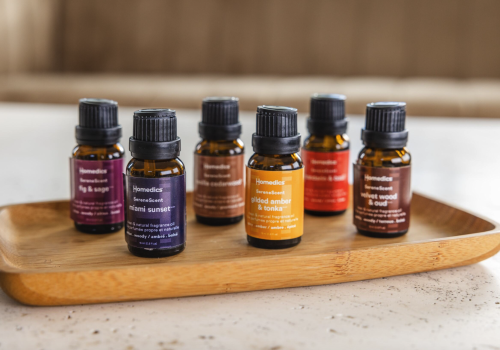Swedish Massage vs. Deep-Tissue Massage
Swedish massage and deep-tissue massage are two of the most popular massage techniques in the modern world. These techniques share quite a few similarities but there are key differences to understand that distinguish them.
So, which is better: Swedish versus deep-tissue massage? The answer depends on you.
Learn about what makes each unique to find out which type of massage therapy might be your preferred style.
Main Differences Between Swedish and Deep-Tissue Massage
Although many people use both Swedish massage and deep-tissue massage to help relieve general tension and discomfort, these two types of massage therapy use different massage techniques to perform different functions.
Swedish massage is the type of massage you probably first think of. It uses steady, gentle pressure from the hands to massage muscles that commonly feel tension from general activity, such as neck soreness from sitting at a desk or back soreness from a long day on your feet.
Deep-tissue massage targets the layers of soft tissue below the surface, where knots and tension can cause muscle soreness. A deep-tissue massage is more intense and involves stronger intense pressure to loosen tight muscles.
Purpose of Swedish Massage
Swedish massage—also called classic massage therapy—aims to promote relaxation and help relieve some surface-level muscle tension.
During a Swedish massage, a massage therapist will apply slow, kneading pressure and circular movements to help your body relax and feel more pleasant overall.
Common Swedish Massage Techniques
Effleurage: The massage therapist slides their palms slowly over the client’s skin, pressing gently and using oil or lotion to reduce friction.
Petrissage: The massage therapist uses their hands to gently knead and roll the muscles and apply finger pressure, moving from one small area to another.
Tapotement: The massage therapist uses rapid, percussive movements to apply repeated pressure to the skin and muscles.
Targeted Areas of Swedish Massage
A Swedish massage can target your whole body, from neck and shoulder muscles to legs and feet. Since it’s a general relaxation treatment, you can have a Swedish massage wherever it feels most comfortable, relaxing, and soothing to you.
Common areas of tension and soreness include:
- Neck
- Shoulders
- Lower back
- Feet
- Legs
What Happens During Swedish Massage
It’s common to lie on your stomach for a Swedish massage. During a session, the therapist might ask you to flip over, especially if you’ve indicated a specific area that’s sore.
In most cases, you’ll remove most of your clothes for a Swedish massage. You can almost always leave your underwear on. Meanwhile, your body will be covered by a towel. Sometimes, you may be able to wear loose-fitting clothing during a Swedish massage.
As the massage therapist works over your muscles, they’ll fold back parts of the towel to reveal only the specific area they’re working on.
To make it easier to apply kneading pressure and make the process more comfortable for you, a Swedish massage therapist will use lotion or oil.
The Swedish massage technique primarily uses the fingers and palms to apply pressure to your muscles. You can always tell the massage therapist if they’re using too much or too little force with this massage technique.
Purpose of Deep-Tissue Massage
Deep-tissue massage is a more targeted, recovery-focused form of massage therapy. A deep-tissue massage aims to relieve tension, soothe soreness, and loosen knotted muscle tissues from exercise or strenuous activity.
A deep-tissue massage uses deep, targeted hand pressure to penetrate deeper layers of muscle tissue. It uses similar hand movements and techniques but with much higher intensity. This type of massage may be less immediately comfortable than a Swedish massage.
Deep-tissue massage can also be considered a sports massage for dealing with the more severe tension that comes with high-exertion exercise and physical activity.
Deeper layers of muscle tissue might become rigid and sore. When this happens, you feel muscle knots, or adhesions—areas of inflexible tissue that can cause stiffness. As a massage therapist releases these areas of muscle contraction, it can bring soothing relief and promote relaxation.
About Fascia
What is fascia? Fascia is the soft tissue that connects all your muscles, organs, and bones throughout your body. Fascia fibers can become knotted, too. When adhesions form in the fascia, they can press against surrounding muscle tissue and cause soreness.
A deep-tissue massage can also target fascia and the surrounding tissue to try to loosen knots.
What Happens During Deep-Tissue Massage
While a deep-tissue massage can cover the entire body, it’s more common to focus on specific areas where you’re feeling chronic muscle pain or soreness.
As you lie on the body massage table or bed, the therapist will use their hands to start applying gentle pressure to your muscles. They will steadily increase the pressure, eventually pressing deep into your muscles to reach the problem areas below the surface-level tissue.
A deep-tissue massage therapist will start by using their fingers and palms. As they increase pressure, they may also use their knuckles, forearms, and elbows. Because of the deep pressure being applied, the massage could become mildly uncomfortable. If you feel discomfort, you should tell the therapist so that they can adjust their technique.
After a deep-tissue massage, you may feel sore for up to a few days. You can try applying ice or gently stretching to help relieve the soreness.
If you’re only receiving a deep-tissue massage on one area or a few specific areas, you likely won’t need to fully undress. If you do have to uncover sensitive areas, the therapist will use a towel to keep you covered while they work.
Swedish vs. Deep-Tissue Massage: Which Is Better?
Determining which type of massage therapy is better depends on your lifestyle and specific needs.
Think about how you’re feeling and what you’re feeling, and whether it’s a specific issue or a general feeling.
Are you feeling generally tense or experiencing stressful circumstances and want to relax? A Swedish massage may be a soothing experience for you. Swedish massage is well-suited to relieving the high daily tension that you may experience, often in your neck or back.
Are you feeling soreness in specific muscles and are regularly active or frequently exercised? A deep-tissue massage may help loosen muscle knots and promote relaxation.
Swedish massage may be helpful for:
- People feeling tense because of stress
- People who sit for long periods and feel tension in their neck, back, or shoulders
Deep-tissue massage may be helpful for:
- Athletes
- Manual workers
- People with some kinds of chronic pain
Both types of massage offer some general health benefits, and each type also offers some specific health benefits.
Health Benefits of Swedish Massage
1. Promote relaxation
The calming environment and steady pressure of a massage therapist’s hands provide an experience that many people find relaxing. Especially after a long day of physical or mental work, a Swedish massage may help you feel relaxed and comfortable.
2. Relieve tension
General tension can build up as you sit, work, walk, and do household chores or other physical activity. A Swedish massage aims to help relieve some of this tension in your muscles, allowing you to lie still and let the massage therapist work away tension. Swedish massage also produces soothing sensations in your nerves and muscles.
3. Help induce calmness
Feelings of stress can be difficult to escape, but a Swedish massage is an opportunity to focus on the present moment and enjoy the soothing pressure. Thinking of your Swedish massage time as the time for stress relief outside of your normal responsibilities will help you get the most out of the session.
Health Benefits of Deep-Tissue Massage
1. Loosen muscle knots and adhesions
It’s the primary focus of deep-tissue massage: loosening the knotted soft tissue that can cause soreness and discomfort.
2. Help improve mobility
The mobility of your soft tissue impacts your flexibility and the range of motion of your joints and muscles. Increased flexibility has multiple benefits for your overall health, including lubricating joints and helping prevent muscle fatigue and muscle tension. A 2017 study on shoulder mobility found that massage therapy significantly improved shoulder range of motion.
3. Increase blood flow
Circulation through your body helps remove toxins and provide nutrients to recovering muscles. One study showed that people who received massage therapy after exercise had better blood flow up to 72 hours after exercising.
Swedish vs. Deep-Tissue Massage: 2 Relaxing Therapies
General versus specific, relaxation versus sports—the question of Swedish versus deep-tissue massage comes down to a few key differences.
Which is better for you depends on your needs and your intended experience. But the aspects that these popular techniques share make them both relaxing, refreshing experiences.
Medical Disclaimer: This content is provided for informational purposes only and is not intended to be a substitute for professional medical advice, diagnosis, or treatment.
Sources
Deep Tissue Massage, National University of Health Sciences: https://www.nuhs.edu/patients/health-information/articles/deep-tissue-massage/
Flexibility, UC Davis Sports Medicine: https://health.ucdavis.edu/sportsmedicine/resources/flexibility_descriprion.html
Yeun Y. R. (2017). Effectiveness of massage therapy on the range of motion of the shoulder: a systematic review and meta-analysis. Journal of physical therapy science, 29(2), 365–369. https://doi.org/10.1589/jpts.29.365
Massage Therapy Restores Peripheral Vascular Function After Exertion, Archives of Physical Medicine and Rehabilitation: https://www.archives-pmr.org/article/S0003-9993%2814%2900130-0/fulltext





